In March of 2009, Michael Bloch and Andres Hoyos-Gomez wrote a terrific article outlining the ways in which organizations, specifically CIO’s, should approach how they spend time and money on IT. Too often, we see companies go on a “spending freeze” for IT, halting existing initiatives and cancelling upcoming ones, only to see a surge in operational spending. The article below from Bloch and Hoyos-Gomez dives deep into the ways organization should see their spending within IT, and how they can make improvements for the business.
If there’s any issue that routinely frustrates executives in many organizations, it’s how to get a true fix on the value that information technology adds to the businesses it serves. IT is undoubtedly central to creating value and therefore continues to account for a rising share of total investment. But defining, measuring, and maximizing that value remain elusive. To throw light on this crucial issue, McKinsey collaborated with CIGREF to study the best practices of major French and international companies across various sectors.
We interviewed 11 CIOs from French companies over a period from March 2007 to November 2007. The in-depth nature of these interviews provided valuable insights, as it allowed us to draw directly from the experiences of CIOs—many of whose companies have successfully used IT to gain competitive advantage. Analyzing their approaches to information technology helps to show how it can promote economic performance. We complemented these insights with international case examples.
Generating value-in-use
IT generates value at two complementary levels (Exhibit 1). The core asset value includes tangible items such as hardware and software, as well as softer benefits such as the IT organization’s processes and skills. IT’s vitally important value-in-use varies with a company’s core business priorities, such as whether it aims for an organizational transformation or operational excellence. A different set of metrics is needed to measure value-in-use, to account for both its economic and strategic dimension.
Exhibit 1
IT–generated value
IT generates value at two complementary levels: the core asset value (eg, hardware and software) and the vitally important value-in-use.
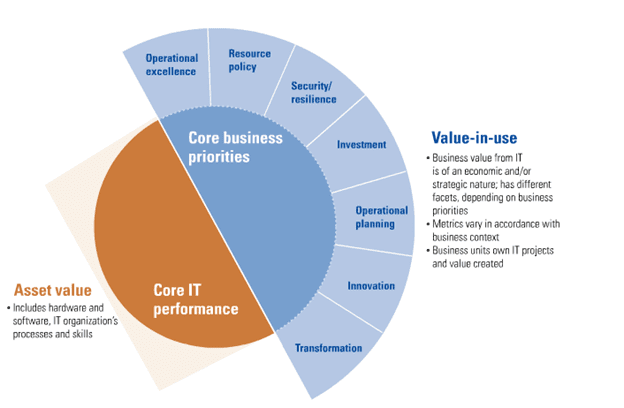
Optimizing investment value
Take the example of a group focused on optimizing investments among its various businesses—say, a banking group with multiple business units such as retail banking, consumer finance, capital markets, asset management, and the like. The economic value expected from the IT department can be measured through the improvement in the overall cost-to-revenue ratio, while the strategic value can translate into a competitive edge in terms of investment or acquisition capacity. (Since 80 to 90 percent of all synergies from banking mergers involve reducing the cost of operations, IT is indeed a key enabling factor during an acquisition.) The indicators that are tracked will be mainly financial, such as the ratio of IT spending to revenue, and will then be compared with the operating ratio—for example, operating costs over revenue (Exhibit 2).
Exhibit 2
Operating costs versus IT spending
In the context of optimizing investments, the value of IT derives from dynamic control over the impact of IT investments on each company’s operating ratios.
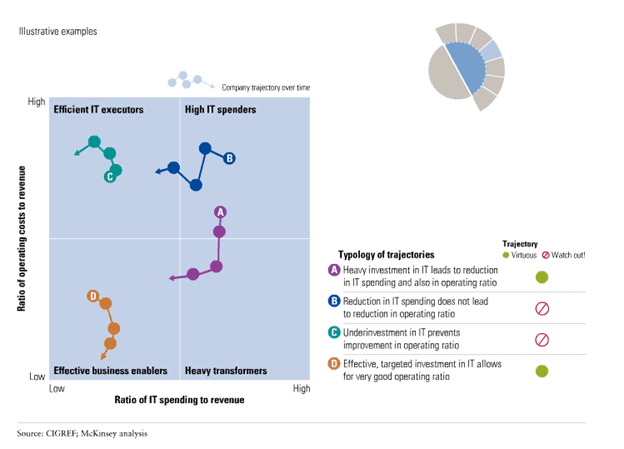
Measuring operations value
Similarly, in companies for which the priority is operational excellence (understood as quality and productivity of processes), the business value from IT will be measured in terms of key performance indicators (KPIs) at the process level. For example, IT will be seen as valuable if the systems helped to reduce the delay for processing an insurance claim or to ensure a no-error delivery of supplies to the production line (Exhibit 3).
At one global logistics company in our study, IT greatly improved supply chain operations—a key factor in a radical transformation—by helping the company to optimize its parcel-loading and truck-routing activities and to develop new value-added services, such as same-day delivery and made-to-order solutions for customers. IT also provided important data for more efficient risk management and better pricing.
Exhibit 3
Performance measures
For CIOs focused on operational improvements, IT’s value is measured mainly by process performance indicators: productivity, on-time delivery, and quality.
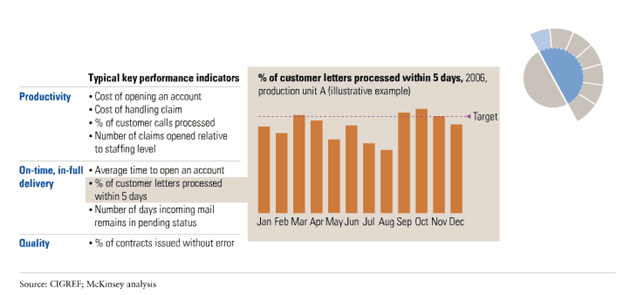
Finding levers where IT and business units intersect
Traditionally, a CIO’s main responsibility has been using standard practices and performance measures to maintain IT’s asset value. Developing value-in-use is a different ball game, however, and CIOs need to examine new levers found at points where the IT department and the business units intersect (Exhibit 4). To succeed, CIOs must take on new roles—bridging functional silos—that may take them beyond their comfort zones. For one thing, they will need to collaborate with executives in the business units to work on major transformation projects, to coordinate strategic planning, or to manage investments collaboratively (see sidebar following this article, “Next steps: Identifying the challenges”).
Exhibit 4
Business performance through IT
Developing value-in-use requires a CIO to examine new levers found at points where the IT department and the business units intersect.
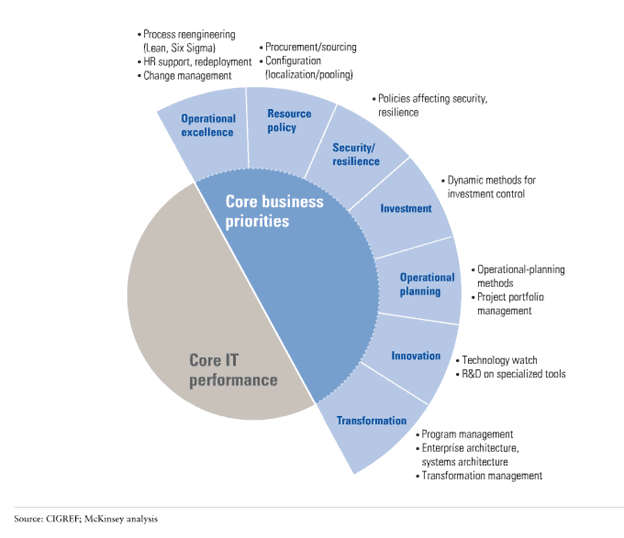
Seeking alliances
Cementing new alliances within the organization is critical (Exhibit 5). A CIO in charge of optimizing IT investments at the group level will need to assume responsibility for managing a portfolio of investments. To do so effectively, the CIO will have to join forces with the CFO, who has expertise in maximizing returns on investment. If the corporate goal is operational excellence, HR is more likely to be the CIO’s preferred ally. This is due to the critical role of change management. Take the example of deploying a new enterprise-resource-planning (ERP) system: the critical challenge is ensuring that the target processes are codified correctly in the system, and that when it is implemented, the end users are sufficiently trained to effectively leverage the potential of the new tool. This requires a joint effort from HR and IT to synchronize and coordinate their tasks from the initial design to the rollout and subsequent life of the system.
Exhibit 5
Building alliances
The CIO builds alliances with peers in areas relevant to supporting the company’s priorities.
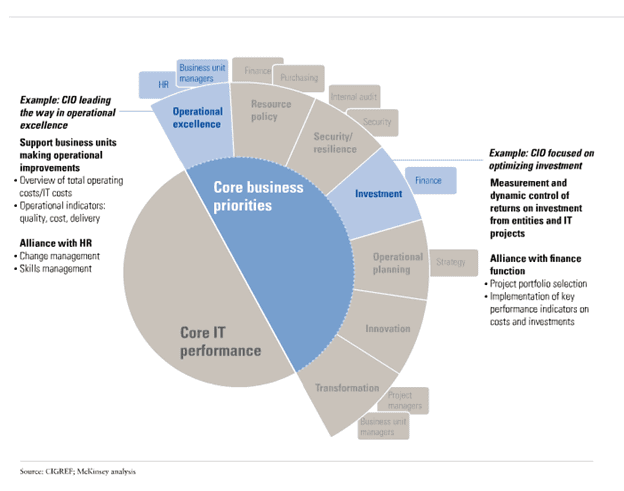
Building better governance
The businesses that are the best at creating value-in-use, we found, embed their IT governance within the broader governance practices. In practical terms, this requires IT representatives to participate in company forums that traditionally have been the exclusive domain of business unit leaders. At successful companies, certain core business processes, such as managing the business project portfolio or determining the allocation of resources, dovetail with IT processes. This notion of an integrated business–IT governance model can also apply the other way around: we have witnessed examples of companies where strategic planning for IT actually serves as a platform for broader strategic planning by establishing mixed business–IT forums (Exhibit 6).
Exhibit 6
IT–inclusive strategy
The best companies at creating value-in-use embed their IT governance within the broader governance practices.
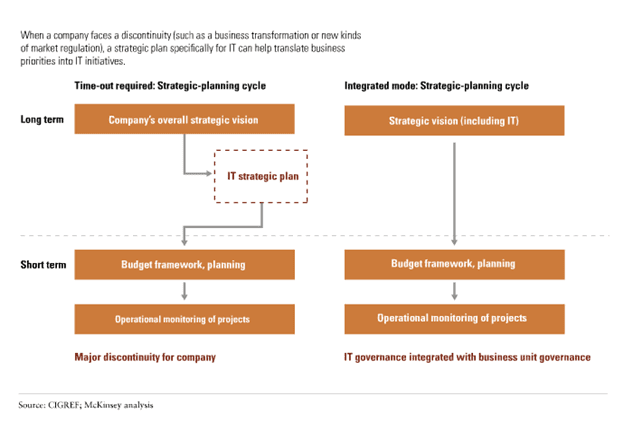
Putting it all together
Sidebar
Next steps: Identifying the challenges
At the best companies in our study, the CIO, the CEO, and the business units essentially cocreate value-in-use when they integrate the elements of our framework (Exhibit A). But to tap the potential reservoir of value, the new partners must have a clear view of the challenges they face (Exhibit B).
Dynamics of value creation through IT
Creating value through IT: Benefits and challenges
CIOs need to understand what the business units expect from the IT organization and to articulate IT goals in terms that business leaders can grasp. That means eschewing technology jargon, making innovative proposals, and taking firm positions on cross-functional projects. To be secure in these new roles, CIOs must develop a range of skills that transcend their IT core competencies; to give the emerging collaborative effort better grounding, they should create forums where IT and the business units can set common priorities.
For CEOs and business unit leaders, the main issue is mind-sets: they need to stop thinking of IT as a service provider and consider ways to build alliances with IT executives. IT priorities should be set in clear business terms. Leaders of businesses should proactively draw their IT counterparts into strategic and operational planning sessions.
When this approach works, it produces a range of benefits. Fresh synergies between IT and the business units create a wider palette of skills for both as they take ownership of shared projects and increase the intensity of their interactions. With leaders from the two groups finally reading from the same script, communications become more efficient, since less translation time elapses between the formulation of business plans and their execution by IT. Of course, the real bottom line is that these benefits combine to raise IT’s value-in-use across the enterprise.
A simple framework summarizes the best practices we observed in our interviews (see Exhibit A in sidebar, “Next steps: Identifying the challenges”). The value-in-use of information technology emerges when the IT department, building on a foundation of core performance, attacks problems and seeks solutions in areas that interest the business units and IT alike. Alliances with business leaders create new roles for CIOs and increase their scope of action. Governance practices that bring IT and business leaders together institutionalize this new way of operating.
To see the article in its entirety, please visit https://www.mckinsey.com/insights/business_technology/how_cios_should_think_about_business_value.
If you would like to speak with PEI about your organization’s strategy and how to get more for your investment within IT, please send an email to info@pei.com and we will reach out to you shortly.
Martin Feehan, PEI




